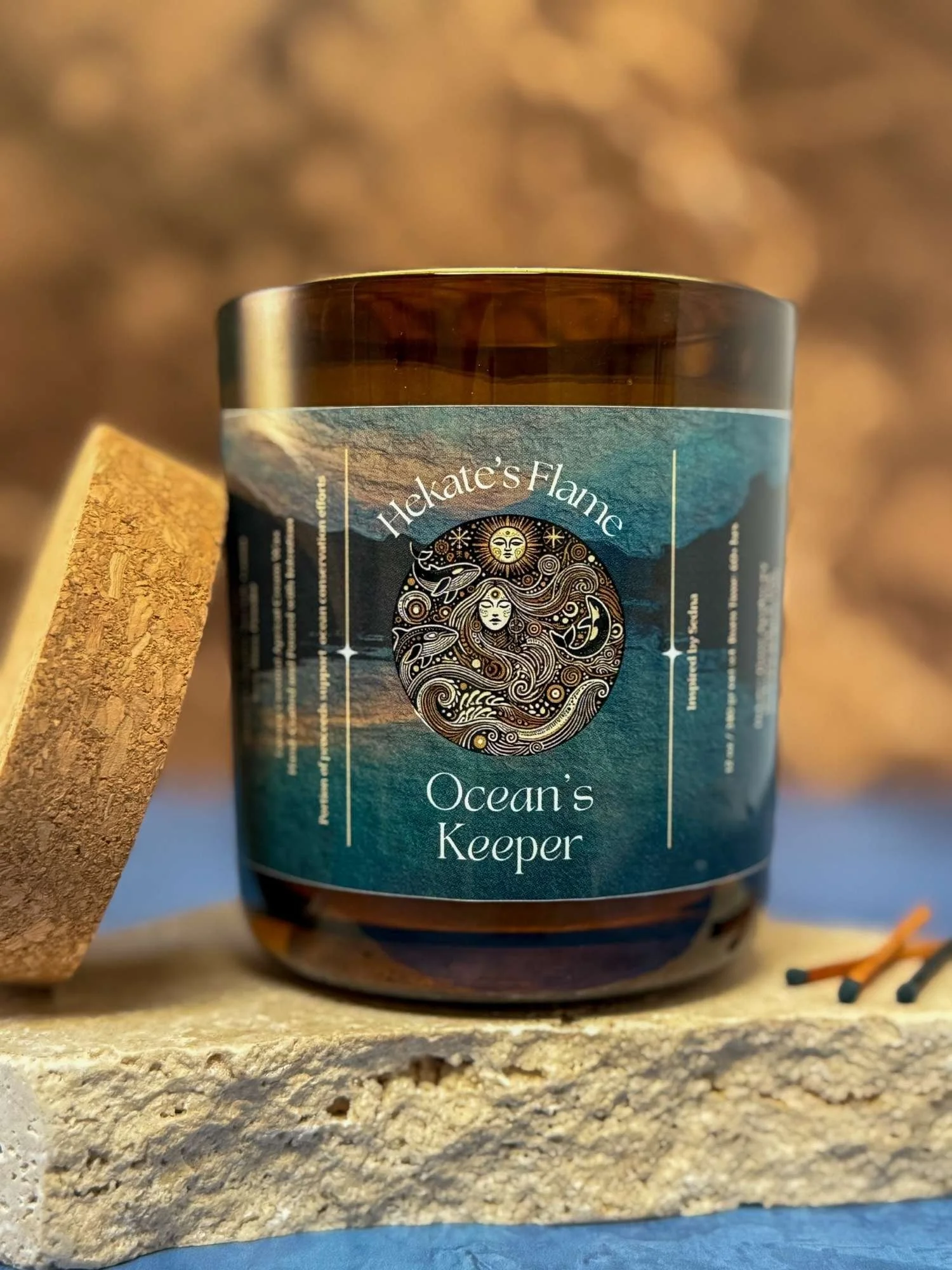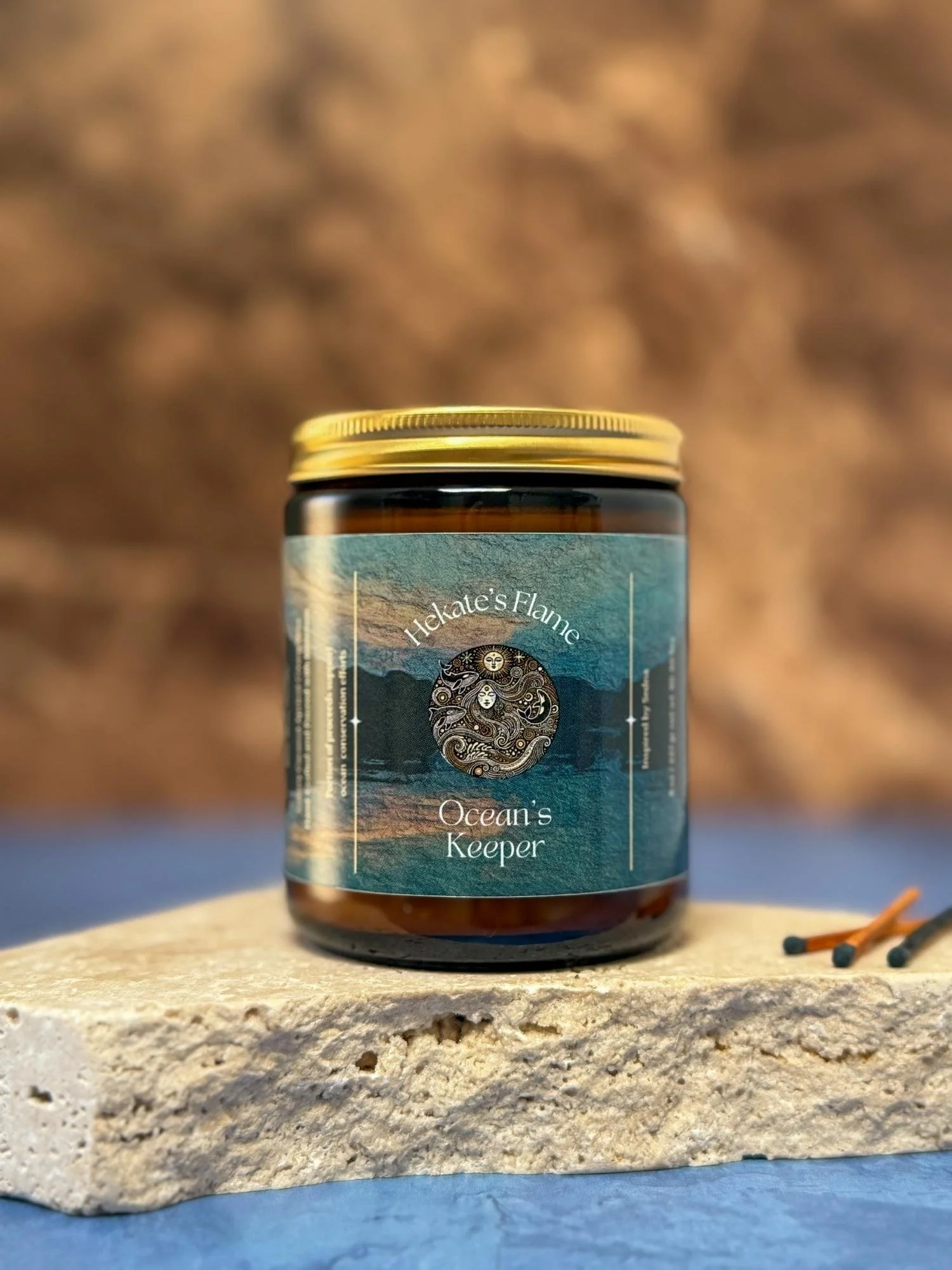‘Siren’s Song’: a handmade artisanal candle inspired by the Sirens, the enchanting beings of Greek mythology known for their haunting song
She who sings to the tides and haunts the edge of longing
Imagine a silver horizon where sea and sky blur, the air alive with wind and wonder. That is the essence of Siren’s Song: salt air and lemon bright as sunlight on water, melon and aldehydes shimmering like mist, and lily, rose, and cyclamen unfolding in soft, hypnotic beauty. Musk and cedarwood linger like driftwood and memory. A scent of allure and mystery, honoring the Sirens whose voices still echo where the waves meet the unknown.
Scent Notes:
Top: Salt Air, Aldehydic, Lemon, Melon
Heart: Lily, Rose, Cyclamen
Base: Musk, Cedarwood
☀️ Season Scent: Summer
🌊 Primary Scent Family: Marine & Ozonic
🌸 Secondary Scent Family: Floral
Please visit this blog post for more information on Scent Profiles, Top, Heart, and Base Notes.
Our candles are lovingly handcrafted in our home studio, Nimue’s Lair, nestled in Walnut Creek, CA. Each one begins with a luxurious blend of coconut-apricot wax, carefully infused with premium fragrance oils. Poured by hand into elegant glass vessels and amber jars, they’re finished with hand-cut labels and enchanted final touches. Every candle is a small ritual, infused with magick, intention, and the quiet glow of story.
-
12 oz Deluxe – Amber Aura Glass · Coco Apricot Wax
Burn Time: 60+ hours
Bold and enduring, this candle fills your space with myth and memory. Crafted for spacious sanctuaries, this candle shines in wide-open living rooms, high-ceilinged studios, and sacred hearths ~ places where scent is free to roam and the flame becomes a luminous companion to stillness and story.8 oz Classic – Amber Jar · Coco Apricot Wax
Burn Time: 50–60 hours
A perfect size for quiet corners and thoughtful pauses. Let it warm your reading nook, home office, or bedside altar, where its flame flickers like a whisper of intention.4 oz Petite – Amber Jar · Coco Apricot Wax
Burn Time: 20–25 hours
Small in size, rich in presence. This candle is ideal for travel, gifting, or sanctifying intimate spaces - guest rooms, personal altars, or quiet corners where scent and flame are invited to linger with intention. -
For detailed information about our waxes, wicks, fragrance blends, and vessels, please see our Ingredients & Materials Guide.
-
For guidance on how to tend your flame with care, ensuring the cleanest, safest, and most enchanting burn, please visit our Candle Care Guide.
-
Please visit the Shipping and Returns Information page for details.
-
All photographs, images, and written content on this website are original works of Hekate's Torch Apothecary, LLC (doing business as Hekate’s Flame Apothecary) and are protected by copyright. They may not be used, altered, shared, or reposted on any platform without explicit written consent. All label designs, photos, images, and content are the exclusive property of Hekate's Torch Apothecary, LLC.
For inquiries regarding the use of our content, please contact: care@hekatesflame.com
© 2025 Hekate's Torch Apothecary, LLC. All rights reserved.
Content Warning:
This post explores ancient myths that include themes of violence, including assault and warfare, which may be sensitive for some readers. Please proceed with care and be mindful of your well-being while engaging with these stories.
Photo images from Unsplash.
The Sirens' Call: A Journey Into the Depths of Greek Mythology
You wake to the gentle lapping of waves against the side of the ship, a peaceful rhythm that lulls you into a false sense of calm. But as you sit up, you realize something is wrong. The deck is too quiet, and the usual sounds of the crew working in harmony are eerily absent. You push yourself to your feet, the boards creaking under your weight, and glance around. The sails flutter loosely in the wind, and the horizon is empty, save for a faint mist clinging to the sea.
Your heart begins to race as you step closer to the edge, scanning the water. Then you hear it, soft at first, almost like a distant whisper, a melody. It dances across the waves, growing louder with each passing second. It's haunting, beautiful, and utterly mesmerizing. You can't help but listen, though you know, deep down, that something isn't right.
You rush toward the bow of the ship, where you find the remaining crew standing frozen, eyes wide, fixated on something beyond the mist. The song swells, wrapping around you like a gentle embrace, and all your fears vanish momentarily. The worries, the dangers of the sea, none of it matters. All that exists is the music.
As your mind fogs, you barely notice your feet carrying you closer to the rail. Your hands grip the wood, knuckles white as the urge to leap overboard pulses through you.
Just beyond the veil of mist, you see them moving gracefully across the surface of the water. They beckon to you, their arms outstretched, their voices laced with promises of peace, joy, and eternal rest.
You struggle to pull back, to scream a warning to your comrades, but your body no longer listens. The song is all that matters now. One by one, the others have already succumbed, stepping overboard into the depths without a word. And now, it's your turn.
With a final, resigned breath, you let go of the rail, plunging into the cold embrace of the ocean. The last thing you hear before the dark swallows you is the sirens' song, as sweet and deadly as the sea itself.
These are the Sirens of ancient Greek mythology, the deadly temptresses whose voices led many sailors to their demise. From Homer's Odyssey to later mythological texts, the Sirens have captivated our imaginations, embodying the ultimate paradox: beauty intertwined with danger
Origins of the Sirens: Daughters of Gods and Muses
The mythological origins of the Sirens are as varied as their depictions throughout history. Some stories describe them as daughters of the primordial sea god Phorcys and one of the nine Muses, goddesses of the arts and sciences. Other sources, like the mythographer Apollodorus, attribute their parentage to the river god Achelous, reinforcing their association with water. This lineage hints at their divine connections to both music and the perilous allure of the sea.
The Sirens' connection to the Muses may explain their extraordinary voices, with some myths suggesting their mother was Melpomene, the Muse of tragedy, or Calliope, the Muse of epic poetry. These divine origins make the Sirens masters of song, their voices both alluring and dangerous. Their connection to the Muses is essential, as it explains their extraordinary voices. The Sirens' ability to sing songs so irresistible that they could bend the will of any listener is central to their myth.
Alternative Lineages of the Sirens: Origins in Water, Art, and Song
The question of the Sirens' parentage extends beyond Phorcys and Achelous. In some versions, they are daughters of Terpsichore or Sterope, which ties their powers directly to art and song. Their fathers, Phorcys or Achelous, symbolize the watery realm, either the sea or river. These interpretations suggest that the Sirens are born from the union of water and art, symbolizing both the sea's fluid and dangerous nature and music's enchanting power.
Scholars have debated the role of the Sirens as infernal or celestial figures. Some theories propose that Sirens were soul birds tasked with escorting the souls of the dead to the underworld. Another theory suggests that they were otherworldly enchantresses, infernal counterparts to the Muses, who charmed the souls of the dead in Hades. Though this theory has largely been debunked, it highlights the Sirens' ambiguous role between life and death, a theme that permeates their myth.
Anthemoessa and the Sirenuse Islands: The Real-World Locations of Siren Legends
The Sirens' legendary island, Anthemoessa, was said to be "rich in flowers," possibly located near Sicily or off the Italian coast.
The Sirenuse Islands, near the Amalfi Coast, are named after these mythological creatures, grounding their myth in Mediterranean geography. These places may be the remnants of where the Sirens lured sailors to their doom, adding a tangible geographical anchor to their elusive and mystical presence.
The Sirens' presence in these coastal regions continues to evoke the timeless allure and danger of the sea, reinforcing their role as gatekeepers to the unknown, both geographical and existential.
The Sirens as Psychopomps: Their Symbolic Link to Persephone and the Underworld
One of the earliest myths connecting the Sirens to the divine is their relationship with Persephone, daughter of Zeus and Demeter. Some stories say that the Sirens were originally companions of Persephone, charged with her protection.
When Persephone was abducted by Hades and taken to the underworld, the Sirens either requested wings from Demeter to aid in their search for her or were cursed by the goddess for failing their duty. This origin story explains their bird-like features, with the bodies of birds and the heads of women, a form that reflects both beauty and monstrosity.
According to these myths, their song is not merely a tool for destruction but a mournful melody, eternally calling for the return of Persephone. This link to the underworld gives the Sirens a more profound symbolic role as guardians of the threshold between life and death, enchanting travelers and leading them to their inevitable demise.
In many versions of the myth, the Sirens are also seen as psychopomps, beings responsible for guiding the souls of the dead to the underworld. As attendants of Persephone, the Sirens took on the sacred duty of escorting the deceased to the realm of the dead. Their haunting song, as much a lament for Persephone as a call to sailors, can be seen as an invitation to death. Some scholars have suggested that the Sirens appeared to those already marked by fate, calling out to souls destined to die. It is said that the true reason that Odysseus escaped their call was that it was simply not his time to join the ranks of the dead.
In another myth, the Sirens' transformation is linked to Aphrodite. Angry at the Sirens for choosing a life of chastity, Aphrodite cursed them with their deadly voices, both a gift and a punishment. Again, in both stories, the Sirens' song represents the combination of sorrow and longing, whether for Persephone's return or for a life they can no longer lead.
Sirens in Art and Myth: The Transition from Bird-Women to Mermaid Figures
In the earliest depictions of the Sirens, they are part bird, part woman. These mixed-human figures are frequently found in Greek art, where the Sirens are shown with the wings and feet of birds and the faces of beautiful women. This "mixed-human" appearance placed them in the same category as other mythical beings like the Minotaur or the Sphinx, creatures that defied natural boundaries.
However, over time, their physical form began to change. By the Hellenistic period, the Sirens began to lose their bird-like characteristics. They were often depicted as more mermaid-like, with fish-tails replacing wings. This shift mirrored broader cultural changes and the growing influence of mermaid mythology. By the Middle Ages, the Sirens were almost indistinguishable from mermaids, with both creatures embodying the duality of beauty and danger that lurks beneath the surface of the sea. The mermaid-like depiction of the Sirens became more popular in later European art and literature, often leading to a conflation of the two figures.
The Sirens' Song in Homer's Odyssey: Knowledge, Temptation, and Destruction
One of the most iconic stories of the Sirens comes from Homer's Odyssey. As Odysseus and his men sail homeward after the Trojan War, they are warned by the enchantress Circe of the dangers posed by the Sirens. Determined to hear their fabled song but avoid their deadly trap, Odysseus devises a clever plan. He orders his crew to plug their ears with beeswax while he is tied to the ship's mast, allowing him to listen without succumbing to the Sirens' lure.
In addition to their allure, the Sirens were more than just deadly temptresses; they were also oracular goddesses. It is said that they held the power to know all that happens on Earth, offering wisdom and prophecy to those who could hear them. Their song was not merely a tool of destruction but an invitation to omniscience. For sailors like Odysseus, the temptation to listen to their song might have stemmed from a desire not only for pleasure but for forbidden knowledge. The Sirens' ability to offer insight into the world's deepest mysteries further enhanced their allure.
As they sail past the island, the Sirens begin to sing, calling out to Odysseus by name and offering him knowledge of the world and its secrets. Their song promises pleasure, insight, and an understanding of the universe. This moment highlights the tension between temptation and wisdom. Odysseus yearns for knowledge but knows he must resist the pull of the Sirens' deadly charm. His survival represents physical endurance and a triumph of reason over desire.
In an alternative version of this story, there is a prophecy that if anyone heard the Sirens' song and survived, the Sirens would die. Odysseus' clever escape from their trap fulfills this prophecy, marking him as the first man to survive hearing their song. As a result, the Sirens, overcome with despair and humiliation at their failure, throw themselves into the sea and perish. Their death adds a layer of tragedy to their myth, transforming them from dangerous temptresses into figures of fate bound by their own power and the inevitability of their demise.
However, in another lesser-known version, the Sirens' defeat at the hands of Odysseus did not end with their death. The Sirens, unable to kill Odysseus, sought revenge on his lineage. According to the mythographer Hephaestion, the Sirens turned their attention to Telemachus, Odysseus' son. Learning of his identity, they lured Telemachus with their voices, seeking to destroy him as a way to restore their lost honor.
Unlike his father, Telemachus could not resist their song. Overcome by its allure, he met his tragic end, succumbing to the very forces that Odysseus had outwitted.
This lesser-known version reveals the enduring reach of the Sirens' vengeance, illustrating that even if one escapes temptation, the consequences may ripple across generations.
Together, these alternative versions underscore the inescapable nature of fate in Greek mythology. While Odysseus' triumph over the Sirens marks him as a hero of unparalleled wit and willpower, his lineage was not spared from their wrath, showing that fate, and the power of mythological creatures, could not easily be defied.
Orpheus and the Sirens: How Music Saved Jason and the Argonauts
Another famous encounter with the Sirens comes in the story of Jason and the Argonauts. As they sail in search of the Golden Fleece, the Argonauts are similarly warned about the deadly voices of the Sirens. However, unlike Odysseus, who relies on restraint and willpower, Jason and his crew have a secret advantage: Orpheus, the legendary musician.
As the Sirens begin their song, Orpheus plays a tune on his lyre that is even more beautiful than the Sirens' voices. His music drowns out their song, breaking their enchantment and allowing the Argonauts to sail safely past their island. Only one Argonaut, Butes, succumbs to the Sirens' song and jumps overboard. However, Aphrodite intervenes, saving Butes from his fate.
The Sirens and Persephone: Guardians of the Threshold
The Sirens are not merely mythical creatures who lure sailors to their doom; they carry profound symbolism connected to death, the afterlife, and the mysteries of the underworld. Their deadly allure is often interpreted as more than just a physical danger; it is the symbolic pull of the unknown, of what lies in the afterlife. This association with death is intricately tied to their connection with Persephone and the asphodel meadows, two elements of Greek mythology that anchor them in the realm of the afterlife.
Indeed, in several myths, the Sirens are companions of Persephone, the goddess of the underworld, and her role is key to understanding their symbolic function. According to these myths, the Sirens were once beautiful nymphs who attended to Persephone before she was abducted by Hades. After her abduction, Demeter cursed or transformed them, giving them wings to search for her daughter. In some versions, this transformation was a punishment for their failure to protect Persephone, while in others, it was a means of aiding their search. Their song, which calls out longingly for Persephone, reflects their deep connection to her fate and to the world of the dead.
This link to Persephone places the Sirens in a liminal space between life and death. Like Persephone herself, who moves between the underworld and the world of the living, the Sirens exist as intermediaries between these two realms. Their island, where sailors meet their demise, can be seen as a metaphor for the boundary between life and death, a final resting place where they guide souls into the afterlife.
The Asphodel Meadows and the Sirens as Soul Birds
The Sirens' symbolic association with the underworld is further reinforced by their connection to the asphodel meadows, a space in Greek mythology where the souls of the dead were believed to dwell. In Homer's Odyssey, the Sirens are described as residing in a "flowery meadow," which scholars have interpreted as an allusion to the asphodel meadows. These meadows are not just fields of ordinary flowers; they are filled with asphodel, a plant linked to the dead and the underworld. In fact, Persephone herself was said to be picking flowers in a meadow when she was abducted by Hades, and it is no coincidence that these blooms are associated with her.
This floral symbolism ties the Sirens directly to the afterlife as they sing their haunting songs amid fields representing the resting place of souls. The Sirens' ability to enchant and claim the lives of sailors can thus be seen as an extension of their role as soul birds, creatures who escort the souls of the dead to the underworld. In this interpretation, the Sirens are not merely monsters but agents of fate, acting as guides who lead the doomed toward their final destination.
The Sirens and the Muses: Duality of Music in Greek Mythology
While the Sirens are destructive, their connection to music and song parallels that of the Muses, who are traditionally seen as the goddesses of inspiration and creativity. Some ancient scholars have drawn connections between the Sirens and the Muses, suggesting that the Sirens are their infernal counterparts, the "Muses of the Underworld." This interpretation casts the Sirens' song as a form of dark inspiration that leads not to enlightenment but to the oblivion of death.
In Plato's Republic, the Sirens are said to preside over the eight concentric spheres of Heaven, singing in perfect harmony and governing the celestial movements of the universe. Their song not only lures sailors to their doom but also regulates the cosmic order, suggesting that the Sirens hold a deeper, cosmic significance. This celestial role elevates them beyond mere tempters of mortals, portraying them as powerful forces governing the balance between life and death, knowledge and destruction, fate and free will.
This duality of song, both creative and destructive, lies at the heart of the Sirens' myth. While the Muses inspire poets and artists to create, the Sirens lure sailors into oblivion. Their beautiful and deadly song embodies the paradox of art itself: it can elevate the soul but also lead it to ruin.
Through this duality, the Sirens serve as a reminder of the thin line between inspiration and obsession, wisdom and destruction.
The rivalry between the Sirens and the Muses is further emphasized in certain myths where they are direct competitors. After losing a singing contest to the Muses, the Sirens were punished. Their feathers were plucked, stripping them of their divine beauty and condemning them to live as temptresses. This defeat symbolizes the triumph of creativity and knowledge over the allure of temptation and destruction, marking the Sirens' transformation from divine songstresses to cursed monsters.
The Sirens and the Sea: Symbolism of Death, Mystery, and Peril
The sea, home to the Sirens, has long symbolized the unknown, the unconscious, and death. Sea voyages were dangerous in ancient times, and many sailors never returned. The unpredictability of the ocean mirrored the uncertainty of death, and the Sirens, poised between life and death, embody this perilous journey.
The ocean's vastness represents more than physical distance; it evokes the untamable forces of nature and the depths of human desires and fears. For sailors, the open sea offered both freedom and destruction, the allure of discovery alongside treacherous currents and unseen dangers. With their haunting voices, the Sirens personified this duality, inviting sailors to explore the seductive unknown, only to lead them to their doom.
The Sirens' song symbolizes the call of the unknown, tempting sailors with promises of knowledge and peace. Yet, like the sea itself, what lies beneath the surface is not always what it seems. Their island, where countless sailors perished, serves as a metaphor for the destructive power of unchecked curiosity and desire. The Sirens lure sailors into surrender, much like the ocean strips away certainty, reminding us that some paths, though tempting, lead inevitably to ruin.
In this way, the Sirens and the sea exist in symbiosis. The sea provides the vast, unpredictable stage where fate unfolds, and the Sirens act as its agents, weaving illusions that ensnare those drawn to explore its depths. They are more than tempters; they are manifestations of the sea's power, embodying both its beauty and its danger just beyond the horizon.
The Sirens' Transformation: From Ancient Birds to Modern Mermaids
In modern culture, the Sirens have often been conflated with mermaids, leading to a blending of their characteristics. Where Sirens were once depicted as bird-like creatures, today, they are more often imagined as beautiful, fish-tailed women who live beneath the waves. This transformation reflects broader cultural shifts and the romanticization of the sea as a mysterious and enchanting realm.
Despite these changes, the core of the Siren myth remains relevant: they embody the eternal struggle between temptation and wisdom, desire and destruction. Whether as bird-women or mermaids, the Sirens continue to captivate our imaginations, reminding us of the dangers of pursuing forbidden knowledge.
Cultural Impact: Sirens in Modern Films, Literature, and Music
The Sirens' influence has extended far beyond ancient Greek mythology, becoming a recurring motif in modern literature, film, and music. Their iconic role as dangerous seductresses continues to resonate, although their depictions have evolved with time and culture.
In literature, Siren-like characters appear frequently in fantasy and horror genres. Margaret Atwood's Siren Song offers a unique and provocative perspective on the ancient myth of the Sirens by giving voice to one of these fabled creatures. Traditionally depicted as seductive temptresses whose songs lure sailors to their doom, Atwood's Siren expresses discontent and boredom with her role. She feels trapped by her allure, revealing that the "irresistible" song is not one of power but of entrapment and monotony. This portrayal adds a layer of vulnerability to the Siren, highlighting how she is also caught in a cycle of manipulation and unable to escape her own myth. By asking to be freed from her "bird suit," the Siren longs to escape the role forced upon her, suggesting a deeper commentary on the ways in which women, in particular, are bound to certain expectations and roles imposed by society.
The poem's tone is laced with irony as the Siren mocks her song's supposed mystery and danger, ultimately revealing that it is "a boring song, but it works every time." This twist challenges the traditional romanticized view of the Sirens as irresistible temptresses, reducing their allure to something mechanical and predictable. Atwood's reimagining of the Siren myth critiques how women are often objectified or reduced to symbols of desire and destruction while stripping them of actual agency. The Siren's plea for help is a cry not just for freedom from her mythological prison but liberation from societal expectations' constraints, adding psychological depth and feminist critique to this ancient tale.
In films, the Sirens often symbolize temptation and chaos. In the 2000 film O Brother, Where Art Thou?, the Sirens appear as beautiful women bathing in a river, seducing the protagonists and almost leading them to ruin. Here, the Sirens retain their enchanting power but are depicted as human women, bringing their ancient menace into a more familiar, modern context. The blending of their allure with themes of deception speaks to the ongoing fascination with their mythical role.
The transformation of the Siren myth into the character of Ariel from Disney's The Little Mermaid reveals a significant shift in how society views the themes of temptation, sacrifice, and power. While Ariel lacks the deadly allure and predatory nature of her mythological predecessors, her voice is still central to her story, echoing elements of both the original Hans Christian Andersen tale and the Siren's seductive power.
In both Andersen's version and the Disney adaptation, the mermaid's voice is symbolic of her identity and agency, yet how this power is portrayed and its consequences differ dramatically, highlighting contrasting narratives of desire and self-empowerment.
In Disney's retelling, Ariel's voice is a tool of empowerment, representing her free-spirited nature, individuality, and longing for a world beyond the ocean. When she trades it to Ursula, the sea witch, Ariel's sacrifice is framed as an act of youthful rebellion driven by love and the desire for independence.
The story's resolution restores her voice, symbolizing her triumphant reclaiming of her power as she secures both her romantic desires and a place in the human world. This narrative transformation portrays Ariel's journey as one of self-discovery, aligning with Disney's focus on personal fulfillment and a happy ending, where the heroine's sacrifice is ultimately rewarded.
In contrast, Andersen's original story is far darker, where the mermaid's loss of voice signifies a relinquishing of her very essence. When she sacrifices her voice, it is not only a loss of speech but of her ability to express her emotions and communicate her love. This silence renders her powerless and passive, symbolizing the cost of conforming to human standards and abandoning her true nature. Unlike Disney's Ariel, who ultimately regains her voice and agency, Andersen's mermaid is left without a voice, unable to assert herself or sway her fate. Her sacrifice is ultimately in vain, as she fails to win the prince's heart and faces a tragic end, dissolving into sea foam when he marries another. While her selflessness is rewarded with spiritual transformation rather than eternal oblivion, her voice is never restored, highlighting the permanence of her loss and the irreversible consequences of her sacrifice.
From literature to film and music, the Sirens' mysterious, seductive, and perilous mythological essence remains alive in modern interpretations. Their story continues to evolve, but their allure remains unchanged, drawing audiences across time into their beguiling and dangerous world.
The Lasting Legacy of the Sirens
The Sirens of Greek mythology have endured through the centuries as symbols of beauty, danger, and the irresistible pull of desire. Their haunting songs, which lured sailors to their doom, continue to resonate in modern storytelling, where they serve as cautionary figures about the consequences of giving in to temptation. But beyond their deadly allure, the Sirens embody deeper truths about the human condition.
Their song is not only a seductive trap but also an invitation to forbidden knowledge and an encounter with fate. In their dual role as tempters and oracles, they represent the allure of insight that comes at too high a price. To hear the Sirens' song is to confront the mysteries of the universe, to challenge the boundaries between life and death, and to realize that some truths are as dangerous as they are enlightening. This makes the Sirens not just temptresses but figures of transformation whose call beckons the soul toward enlightenment and destruction.
Just as the sailor in the opening of our story felt his feet drawn toward the edge of the ship, unable to resist the Sirens' call, we, too, are often drawn by what seems enticing yet dangerous. The Sirens represent the struggle between wisdom and desire, fate and free will, a struggle transcending time. We all face our own Sirens, whether through tantalizing choices or temptations that mask themselves as beauty or knowledge. We must decide whether to heed their call or sail past them with our hearts and minds intact.
In the end, the Sirens' song, as sweet and deadly as it is, serves as a reminder that some knowledge and some experiences carry a price too high to bear. The Sirens' allure may never fade, but neither will the lesson that their myth imparts: a warning against temptation and the peril of seeking too deeply into the mysteries of the world, where the cost may be our very soul.
References:
Christou, M. (2017, December 13). The Sirens of Greek mythology – (Greek mythology explained) [Video]. YouTube. Mythology & Fiction Explained. https://www.youtube.com/watch?v=jVVL_zPsMNI&t=74s
Hamilton, E. (2017). Mythology (75th Anniversary Illustrated Edition): Timeless Tales of Gods and Heroes. Hachette UK.
Illes, J. (2010). Encyclopedia of spirits: The ultimate guide to the magic of fairies, genies, demons, ghosts, gods & goddesses. Harper Collins.
Lady of the Library. (2022, October 6). The dark origins of Sirens | Dark mythologies [Video]. YouTube. https://www.youtube.com/watch?v=T_30aBPbLl8&t=3s
Littleton, C. S. (2002). Mythology: the illustrated anthology of world myth & storytelling. Duncan Baird.
Λουκόπουλος, Κ. (2021, October 14). Σειρήνες: Μαγικές, Επικίνδυνες και Όχι από το Αιγαίο! | Ελληνική Μυθολογία [Video]. YouTube. The Mythologist. https://www.youtube.com/watch?v=7fZBK87nyFk
"Lovely Terpsikhore (Terpsichore), one of the Mousai (Muses), had borne them [Seirenes (Sirens)] to Akheloos (Achelous), and at one time they had been handmaids to Demeter's gallant Daughter [Persephone], before she was married, and sung to her in chorus. But now, half human and half bird in form, they spent their time watching for ships from a height that overlooked their excellent harbour; and many a traveller, reduced by them to skin and bones, had forfeited the happiness of reaching home.”
~ Apollonius Rhodius, Argonautica








































































































